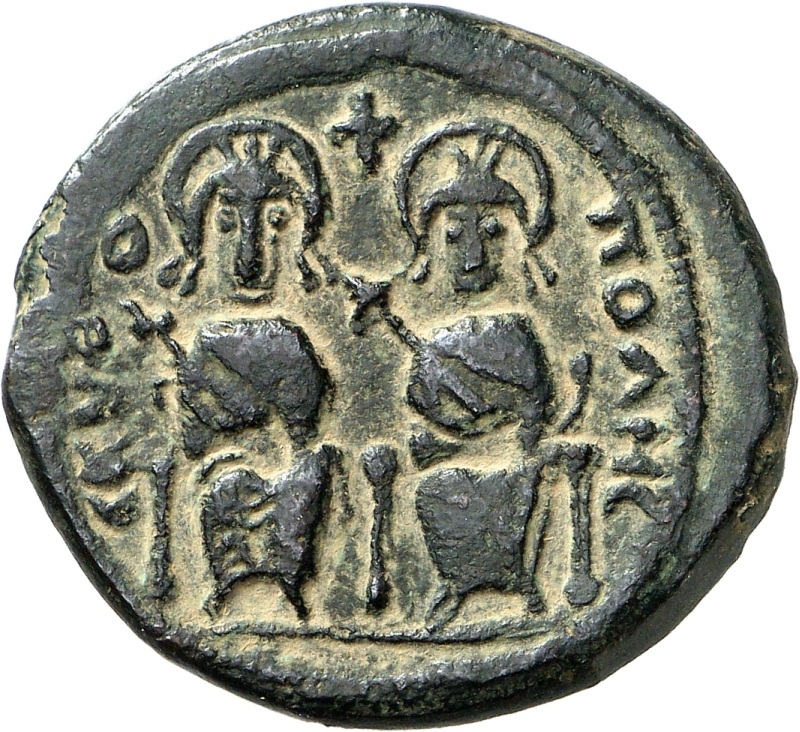arab-byzantine - circa ah 60-72 (679-691). - Coin Auctions
Lot 228 - le monde arabe arab-byzantine - circa ah 60-72 (679-691). - Numismatica Genevensis SA Public Numismatic Auction #8Dynastie Omeyyade. Fals non daté (vers 670-690), Baysan (Skythopolis). L’Empereur byzantin Justin II et sa femme Sophie auréolés, assis de face sur leurs trônes, tenant chacun un sceptre cruciforme / Lettre M majuscule. ANNO - XI de part et d'autre, CON à l’exergue. 12,55g. A - (cf. 3509.1); Walker - (cf. Pl 1, Nicomédie); Goodwin - (cf. 32, Nicomédie). Rare. Très bel exemplaire. Numismatica Genevensis SA Public Numismatic Auction #8le monde arabe arab-byzantine - circa ah 60-72 (679-691). |
|
Lot 229 - le monde arabe arab-byzantine - circa ah 60-72 (679-691). - Numismatica Genevensis SA Public Numismatic Auction #8Banu Nu'man. Fals non daté (VIIème siècle), atelier indéterminé. Un empereur debout, couronné, tenant une lance et un globe, flanqué à gauche de l'inscription "Nu'man" en arabe / M cursif surmonté d'une croix, "Muhammad" en arabe à l'exergue. 3,7g. A -; Walker 140 ; Goodwin -; Foss - (cf. 31). Très rare. Très beau. Numismatica Genevensis SA Public Numismatic Auction #8le monde arabe arab-byzantine - circa ah 60-72 (679-691). |
|
Lot 226 - le monde arabe arab-byzantine - circa ah 60-72 (679-691). - Numismatica Genevensis SA Public Numismatic Auction #8THE FIRST ISLAMIC GOLD COINAGE : THE SOLIDUS. Dynastie Omeyyade. Lot de 2 monnaies en or : Solidus arabo-byzantin non daté, vers AH 60-72 (679-691), et Solidus byzantin d'Héraclius non daté, vers AH 16-20 (638-641). Trois personnages debout de face / VICTORIA - AVGUS. Pilier sur quatre degrés, entre deux monogrammes. CONOB en exergue. Même type, mais avec des croix à l'avers et au revers, pour le prototype byzantin. 4,42g. et 4,49g. Bernardi 4 var. ; Miles 8 pl. XLV var. ; SNG Ashmolean 606 var. (Sear 770 pour le prototype). Un témoin exceptionnel des débuts de l'Islam. Très beau à Superbe. Numismatica Genevensis SA Public Numismatic Auction #8le monde arabe arab-byzantine - circa ah 60-72 (679-691). |
|
Lot 227 - le monde arabe arab-byzantine - circa ah 60-72 (679-691). - Numismatica Genevensis SA Public Numismatic Auction #8THE FIRST ISLAMIC GOLD COINAGE : AN UNKNOWN GOLD FRACTION OF A SOLIDUS. Dynastie Omeyyade. Tremissis non daté, vers AH 60-72 (679-691), atelier indéterminé. DN FOCA - [S]PP AVG. Buste de l'empereur Phocas, coiffé d'un diadème et drapé, à droite / VICTORI FOCAS AVG. Petit palmier. CONO[B] à l'exergue. 1,43g. Bernardi - (cf.1) ; Walker - ; SNG Ashmolean -. Une monnaie curieuse et remarquable. Très beau. Numismatica Genevensis SA Public Numismatic Auction #8le monde arabe arab-byzantine - circa ah 60-72 (679-691). |






